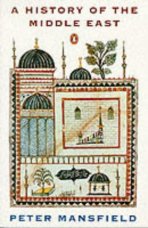
A History of the Middle East
Peter Mansfield
373 pages, including notes and index
published in 1991
A History of the Middle East is of course an incredible big and ill defined subject for any one book, but Peter Mansfield has succeeded in writing an informative and entertaining historic overview of the region. Unfortunately, it is somewhat dated, as it was written almost fifteen years ago and published before the outcome of the first US-Iraqi Gulfwar was known... A lot has happened since its first publication, but even so, I found this to be a good introduction to a difficult subject.
The main focus of the book lies in the modern history of the region, from about 1800 up until the present. Everything before 1800 is dealt with in 35 pages in the introduction... Geographically, the book covers the area bounded by Turkey, Iran, the Arabian Peninsula and Egypt. The Maghreb countries bordering on the Middle East (Libya, Tunesia, Algeria), as well as other countries whose history is interwoven with the Middle East like Morrocco or Aghanistan are dealt with only in passing. They are only included in as far as it is relevant to the history of the core Middle Eastern countires: the countries of the Arabian peninsula, Iran, Iraq, Syria, Jordan and Lebanon, Israel/Palestine and Egypt. Turkey is a special case; because Turkey, or rather, the Ottoman Empire ruled much of the Middle East until World War I, a lot of attention is paid to it too, even if Turkey isn't "really" part of the Middle East.
It is of course always difficult to write an objective history book, especially of an area so steeped in conflicts as the Middle East. Mansfield manages well enough; though his sympathies clearly lie with the indigenous inhabitants of the Middle East, he does not let it colour his history. But since this history is told from their point of view, placed in a (largely) Arabic perspective, you do not get the same examination of Western motives that you get with history from a Europe centred history. Not that this doesn't mean Western reasons for interfering with the Middle East aren't looked at, but the focus lies with how this interference impacted on the population there.
Of central interest to the book is the story of Arab nationalism, which started to develop in the 19th century and its relationship to Islam. Arab nationalism developed against the Ottoman Empire, which saw itself as the defender of Islam. For a long time, Arabs dreamed of creating one Arab state, stretching from Egypt to Iraq, a recreation of the old arab Empire founded by the followers of Mohammed. The question was, would this be an Arab or a Muslim country? It is this question which lies at the heart of A History of the Middle East, together with the related question of how Arab nationalism evolved (or degenerated, according to your point of view) into Egyptian or Syrian or Iraqi nationalism.
The most difficult aspect of writing any book on the Middle East in my view, has to be how to handle the Israel/Palestine situation. Not only do you have to proceed with caution on this issue, lest you cause unwanted controverse, it is also easy to either under or over state this issue's importance in Middle Eastern history. It is of great importance in shaping the history of the Middle East in the second half of the 20th century, but it is not the only such issue.
In general, I think Peter Mansfield did a good job in providing a one volume history of the Middle East, but I wish more time had been spend before the 19th century and somewhat more attention had been paid to the non-Arabic people in the region. There is an updated version of this book, published by Penguin; I would recommend this.
